|
Evaluation of
Panasonic Lumix GF1, GF2 and Olympus E-PL1 Cameras
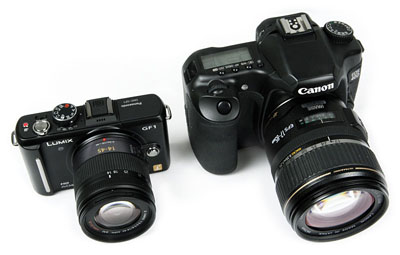
Left:
Panasonic Lumix GF1 camera and 14-45mm f/3.5-5.6 lens
Right:
Canon EOS-40D and EF-S 17-85mm f/4-5.6 lens |
Several micro four thirds cameras (Panasonic and Olympus) were
evaluated as a small, light-weight travel camera to substitute for
my Canon EOS-40D when space and weight restrictions during travel
would benefit from a smaller camera system. The main objective
initially was to compare image quality produced by micro four
thirds cameras with that produced by the EOS-40D. After initial
tests were run, I concluded that additional tests on dynamic
range, resolution and high ISO noise were warranted.
The following cameras were used in the tests:
- Panasonic Lumix G1, GF1 and GF2
- Olympus E-PL1
- Canon EOS-40D and EOS-5D Mark II
|
Initial tests indicated that at low ISO settings (ISO 100-400),
photographs produced by the Panasonic and Olympus micro four thirds
were closely comparable in overall image quality to those produced by
the EOS-40D. Images printed at 16 inches width were hard to tell apart
between the two camera systems other than color output. Auto white
balance and default print color output appeared better in the images
produced by the EOS-40D. In some images with wide lighting extremes,
the images produced by the Panasonic cameras appeared to have blown
out highlights. The images appeared to be overexposed, but it raised
the possiblity that the Panasomic cameras had narrower dynamic range
than the other cameras.
Images produced at ISO 800 with the
Panasonic and Olympus cameras appeared to have high noise. The
following additional tests were run:
- Dynamic range using photographic step tablets and Imatest Master
software
- Noise calculated from step tablet exposures and from SFRplus
with Imatest Master software
- Resolution measured from ISO12233 chart
- MTF50 calculated from slant-edge in ISO12233 chart and from with
Imatest Master software
Initial Photographic Test Images Methods
for image and print preparation
 |
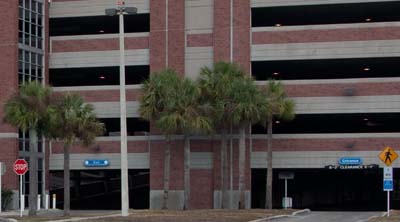 |
| Images of parking garage shot at ISO 100 and f/8
with GF1 camera and 20mm f/1.7 lens, G1 Camera and 14-45mm lens, and
EOS-40D camera with 17-85mm lens. |
Center of parking garage image |
Images of campus dining building shot in a mixture
of bright light and shade with a Panasonic Lumix GF1 camera and 20mm
f/1.7 lens as well as an EOS-40D camera with EF-S 17-85mm lens.
Brick detail in the sunlight in the left of the field is lost
in the GF1 image. Is this overexposure by the GF1 or a
reflection of narrow dynamic range?
Further tests on dynamic
range were run. |
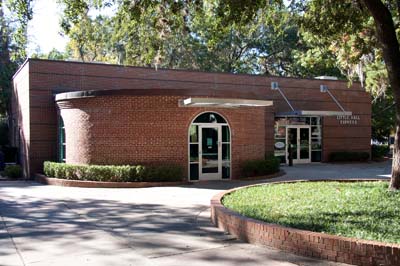 |
Dynamic Range and Noise
Methods
used with Imatest Master and with Step Tablets

Images
of a Kodak Photographic Step Tablet 3 shot with Olympus E-PL1 (upper
panel) and Panasonic GF2 (lower panel) camera.
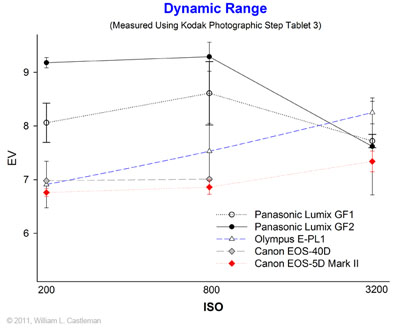
EV
units in this dynamic range test are based on a 0.15 density 21-step
Kodak step tablet and Imatest (see
Imatest
reference).
|
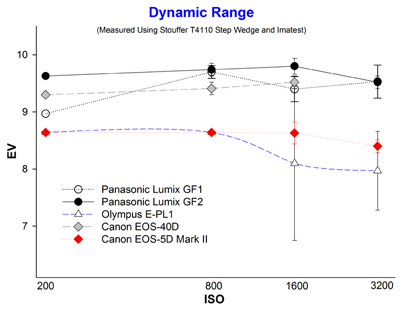
EV
units in this dynamic range test are based on a 0.10 density 41-step
Stouffer tablet and Imatest (see
Imatest
reference). |
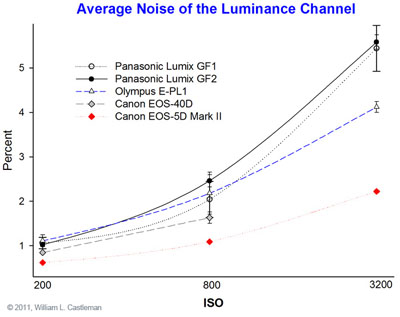
Luminance
Channel Noise from Kodak Step Tablet.
Micro four thirds cameras
had the highest luminance channel noise, especially at high ISO
settings. Mean ± SEM (n=3) |
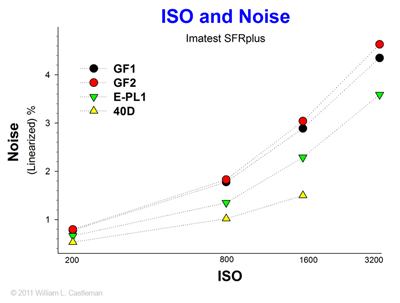
Noise
measured from the SFRplus with Imatest Master.
Mean ± SEM
(n=3) Standard error of the mean is less than the size of the
symbols. |
Resolution and MTF50 Methods
used with ISO12233 chart, SFRplus and Imatest Master
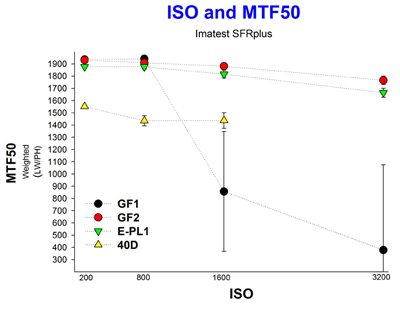
Among
the micro four third cameras tested, the GF2 and the E-PL1 had the
highest MTF50 scores at ISO1600 and 3200. The E-PL1 had the highest
resolution (panel to right). The EOS-40D can't be compared directly
to the micro four third cameras because tests were run with a
different format chip and different lens. The 40D test was run to
see how MTF50 was affected by ISO setting. The GF1 has decreased
MTF50 at ISO 1600 and 3200. Mean ± SEM (n=3) |
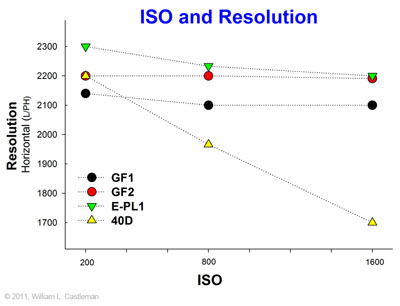
High
ISO settings decreased resolution in the EOS-40D. The micro four
thirds cameras were affected only mildly, if at all. Measurements
made off ISO12233chart. Mean ± SEM (n=3). Standard error is
less than the size of the symbols. |
|
|
|
Conclusions from Tests
After
shooting with DSLR cameras for 11 years, I spent a little time
evaluating micro four third cameras before adopting them as a light
weight travel alternative to the Canon D30, 10D, 20D and 40D cameras I
have been using over the years. The small size and light weight of the
micro four third camera systems is very attractive. My conclusions
based on experience of using the cameras for about 2 months and
extensive testing:
- Quality of 16 inch wide prints prepared from raw files is
comparable between micro four thirds cameras and an EOS-40D. Greater
post-exposure processing may be required to get the color you want
in prints with the micro four third cameras.
- The Lumix GF2 had the greatest dynamic range of the cameras
tested.
- Among micro four thirds cameras, the Lumix GF2 and Olympus E-PL1
had the highest MTF50 scores across all ISO settings
- High ISO noise is greater in micro four thirds cameras than in
Canon EOS cameras that I tested (40D and 5D mark II)
- The Olympus E-PL1 had the lowest noise of the micro four
thirds cameras tested. It also had the highest resolution.
Other tests with micro four thirds cameras using Nikkor lenses
are under way.
|
Snap
shots with micro four thirds cameras
Lenses
Used:
- Panasonic 14-45mm f/4-5.6
- Panasonic 14mm f/2.5
- Panasonic 7-14mm f/4
- Olympus 9-18mm f/4-5.6
- Nikkor 50mm f/1.4 AIS
|
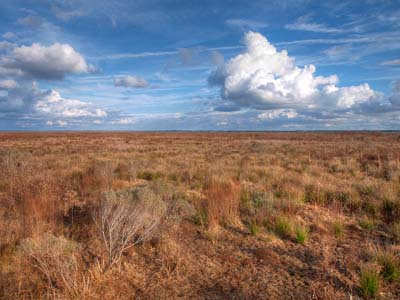
Paynes
Praire
Panasonic GF1 with Olympus 9-18mm lens @ 9mm |
Index
Intially Posted 09 January 2011; revised 17 January
2011 |











